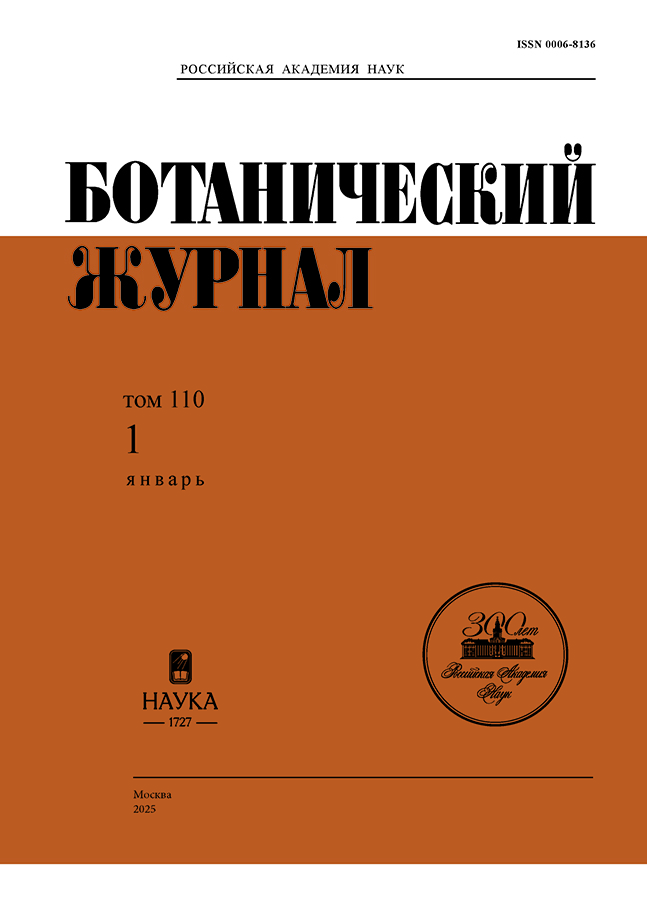Mycorrhizal colonization of root cortex water storage cells of epiphytic orchids
- Authors: Bibikov N.M.1, Voronina E.Y.1, Eskov A.K.1, Ignatov M.1,2
-
Affiliations:
- Faculty of Biology, Lomonosov Moscow State University
- Tsitsin Main Botanical Garden of the Russian Academy of Sciences
- Issue: Vol 110, No 1 (2025)
- Pages: 64-70
- Section: COMMUNICATIONS
- URL: https://edgccjournal.org/0006-8136/article/view/682761
- DOI: https://doi.org/10.31857/S0006813625010037
- EDN: https://elibrary.ru/EMPHRF
- ID: 682761
Cite item
Abstract
In contrast to terrestrial species, epiphytic orchids possess water storage elements as an adaptation to dry habitats. Tracheoidal elements are present in roots and are involved in the interaction with mycorrhizal fungi, which colonize orchid roots obligately. Lignified water storage cells are located in the cortex and perform the functional role of water storage. Among the lignified exodermis cells, thin-walled passage cells are present. These elements are essential for the exchange of water between the root and the environment. This study supports existing data indicating that passage cells are the only exodermis cells through which fungal hyphae can pass. It also presents evidence of water storage cells being colonized by mycorrhizal fungi and shows that lignified elements of cortex are less conducive to peloton formation than thin-walled cortex cells.
Keywords
Full Text
About the authors
N. M. Bibikov
Faculty of Biology, Lomonosov Moscow State University
Author for correspondence.
Email: bibik0808@mail.ru
Russian Federation, Moscow
E. Yu. Voronina
Faculty of Biology, Lomonosov Moscow State University
Email: bibik0808@mail.ru
Russian Federation, Moscow
A. K. Eskov
Faculty of Biology, Lomonosov Moscow State University
Email: bibik0808@mail.ru
Russian Federation, Moscow
M. Ignatov
Faculty of Biology, Lomonosov Moscow State University; Tsitsin Main Botanical Garden of the Russian Academy of Sciences
Email: bibik0808@mail.ru
Russian Federation, Moscow; Moscow
References
- Balachandar M., Koshila Ravi R., Ranjithamani A., Muthukumar T. 2019. Comparative vegetative anatomy and mycorrhizal morphology of three South Indian Luisia species (Orchidaceae) with the note on their epiphytic adaptations. — Flora. 251: 39–61. https://doi.org/10.1016/j.flora.2018.12.001
- Brundrett M.C., Enstone D.E., Peterson C.A. 1988. A berberine-aniline blue fluorescent staining procedure for suberin, lignin, and callose in plant tissue. — Protoplasma. 146: 133–142. https://doi.org/10.1007/BF01405922
- Cameron D.D, Johnson I., Read D.J., Leake J.R. 2008. Giving and receiving: Measuring the carbon cost of mycorrhizas in the green orchid, Goodyera repens. — New Phytol. 180: 176–184. https://doi.org/10.1111/j.1469-8137.2008.02533.x
- Chomicki G., Bidel L.P.R., Jay-Allemand C. 2014. Exodermis structure controls fungal invasion in the leafless epiphytic orchid Dendrophylax lindenii (Lindl.) Benth. ex Rolfe. — Flora. 209: 88–94. https://doi.org/10.1016/j.flora.2014.01.001
- Holbein J., Shen D., Andersen T.G. 2021. The endodermal passage cell — just another brick in the wall? — New Phytol. 230: 1321–1328. https://doi.org/10.1111/nph.17182
- Joca T.A., de Oliveira D.C., Zotz G., Cardoso J.C., Moreira A.S. 2020. Chemical composition of cell walls in velamentous roots of epiphytic Orchidaceae. — Protoplasma. 257: 103–118. https://doi.org/10.1007/s00709–019–01421-y
- Kohler A., Kuo A., Nagy L.G., Morin E., Barry K.W., Buscot F., Canbäck B., Choi C., Cichocki N., Clum A. 2015. Convergent losses of decay mechanisms and rapid turnover of symbiosis genes in mycorrhizal mutualists. — Nat. Genet. 47: 410–415. https://doi.org/10.1038/ng.3223
- Koyyappurath S., Conéjéro G., Dijoux J.B., Lapeyre-Montes F., Jade K., Chiroleu F., Gatineau F., Verdeil J.L., Besse P., Grisoni M. 2015. Differential responses of vanilla accessions to root rot and colonization by Fusarium oxysporum f. sp. radicis-vanillae. — Front. Plant. Sci. 18: 1125. https://doi.org/10.3389/fpls.2015.01125
- Li J.W., Zhang S.B. 2019. Physiological responses of orchid pseudobulbs to drought stress are related to their age and plant life form. — Plant. Ecol. 220: 83–96. https://doi.org/10.1007/s11258-018-00904-x
- Miyauchi S., Kiss E., Kuo A., Drula E., Kohler A., Sánchez-García M., Morin E., Andreopoulos B., Barry K.W., Bonito G. 2020. Large-scale genome sequencing of mycorrhizal fungi provides insights into the early evolution of symbiotic traits. — Nat. Commun. 11: 1–17. https://doi.org/10.1038/s41467-020-18795-w
- Olatunji O.A., Nengim R.O. 1980. Occurrence and distribution of tracheoidal elements in the Orchidaceae. — Bot. J. Linn. Soc. 80: 357–370. https://doi.org/10.1111/j.1095-8339.1980.tb01669.x
- Petrolli R., Augusto Vieira C., Jakalski M., Bocayuva M.F., Vallé C., Cruz E.D.S., Selosse M.A., Martos F., Kasuya M.C.M. 2021. A fine-scale spatial analysis of fungal communities on tropical tree bark unveils the epiphytic rhizosphere in orchids. — New Phytol. 231: 2002–2014. https://doi.org/10.1111/nph.17459
- Porembski S., Barthlott W. 1988. Velamen radicum micromorphology and classification of Orchidaceae. — Nord. J. Bot. 8: 117–137. https://doi.org/10.1111/j.1756-1051.1988.tb00491.x
- Pujasatria G.C., Nishiguchi I., Miura C., Yamato M., Kaminaka H. 2022. Orchid mycorrhizal fungi and ascomycetous fungi in epiphytic Vanda falcata roots occupy different niches during growth and development. — Mycorrhiza. 32: 481–495. https://doi.org/10.1007/s00572-022-01089-y
- Ramesh G., Ramudu J., Khasim S.M., Thammasiri K. 2020. Structural adaptations of Bulbophyllum and Dendrobium (Orchidaceae) to the epiphytic habitat and their phylogenetic implications. — In: Orchid Biology: Recent Trends & Challenges. Springer, Singapore. P. 303–342. https://doi.org/10.1007/978-981-32-9456-1
- Tay J.Y., Zotz G., Gorb S.N., Einzmann H.J. 2021. Getting a grip on the adhesion mechanism of epiphytic orchids-evidence from histology and cryo-scanning electron microscopy. — Front. For Glob. Change. 4: 764357. https://doi.org/10.3389/ffgc.2021.764357
- Xing X., Jacquemyn H., Gai X., Gao Y., Liu Q., Zhao Z., Guo S. 2019. The impact of life form on the architecture of orchid mycorrhizal networks in tropical forest. — Oikos. 128: 1254. https://doi.org/10.1111/oik.06363
Supplementary files














